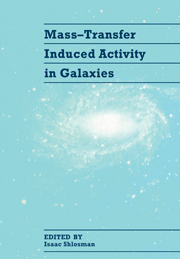Book contents
- Frontmatter
- Contents
- Preface
- List of Participants
- I INTRODUCTION
- II THE INNER PARSEC
- III THE CIRCUMNUCLEAR REGION
- IV GAS DYNAMICS AND STAR FORMATION IN BARRED AND NORMAL GALAXIES
- V NUCLEAR GAS AND LARGE-SCALE PROPERTIES OF AGN AND STARBURST HOSTS
- VI HOST GALAXY-AGN-NUCLEAR STARBURST CONNECTION
- Starbursts, Quasars, and their Environments (Invited paper) 234
- Nuclear Fueling in Two-Component Star-Gas Disks (Invited paper) 251
- Radio Loud Far-Infrared Galaxies 263
- Massive Central Black Holes as Generators of Chaos and Drivers of Large-Scale Dynamics
- Self-Gravitating Gas Dynamics: Growing Monsters and Fueling Starburstsin Disk Galaxies
- Radial Inflows in Disk Galaxies: Effects of Star Formation 279
- Self-Gravitating Gas Dynamics in a Galactic Central Region
- Nuclear Inflow under the Action of Instabilities
- Mid-IR Imaging of Interacting and Non-Interacting AGNs (Poster paper)
- Imaging of MBG Starbursts: Preliminary Results (Poster paper)
- Compact Extranuclear Structures of Mkn 298 (Poster paper)
- NGC 6814: a Very Normal Looking AGN Host Galaxy (Poster paper)
- ROSAT PSPC Observations of NGC 3079 (Poster paper)
- MK 231: AGN vs. Starburst? Steps Toward a Model (Poster paper)
- Extended Starburst Activity Induced by the Central AGN: a Model for NGC 1068 (Poster paper)
- NGC 2782, NGC 4102 and NGC 6764: Evidence for Starburst-Driven Winds
- AGN Winds and Nuclear Starbursts (Poster paper)
- VII GALAXY INTERACTIONS AND INDUCED ACTIVITY
- VIII GAS DYNAMICS IN ELLIPTICALS
- IX AGN AND STARBURST HOSTS AT LARGE REDSHIFTS
- X CONFERENCE SUMMARY
- Subject Index
- Object Index
- Author Index
Starbursts, Quasars, and their Environments (Invited paper) 234
Published online by Cambridge University Press: 05 May 2010
- Frontmatter
- Contents
- Preface
- List of Participants
- I INTRODUCTION
- II THE INNER PARSEC
- III THE CIRCUMNUCLEAR REGION
- IV GAS DYNAMICS AND STAR FORMATION IN BARRED AND NORMAL GALAXIES
- V NUCLEAR GAS AND LARGE-SCALE PROPERTIES OF AGN AND STARBURST HOSTS
- VI HOST GALAXY-AGN-NUCLEAR STARBURST CONNECTION
- Starbursts, Quasars, and their Environments (Invited paper) 234
- Nuclear Fueling in Two-Component Star-Gas Disks (Invited paper) 251
- Radio Loud Far-Infrared Galaxies 263
- Massive Central Black Holes as Generators of Chaos and Drivers of Large-Scale Dynamics
- Self-Gravitating Gas Dynamics: Growing Monsters and Fueling Starburstsin Disk Galaxies
- Radial Inflows in Disk Galaxies: Effects of Star Formation 279
- Self-Gravitating Gas Dynamics in a Galactic Central Region
- Nuclear Inflow under the Action of Instabilities
- Mid-IR Imaging of Interacting and Non-Interacting AGNs (Poster paper)
- Imaging of MBG Starbursts: Preliminary Results (Poster paper)
- Compact Extranuclear Structures of Mkn 298 (Poster paper)
- NGC 6814: a Very Normal Looking AGN Host Galaxy (Poster paper)
- ROSAT PSPC Observations of NGC 3079 (Poster paper)
- MK 231: AGN vs. Starburst? Steps Toward a Model (Poster paper)
- Extended Starburst Activity Induced by the Central AGN: a Model for NGC 1068 (Poster paper)
- NGC 2782, NGC 4102 and NGC 6764: Evidence for Starburst-Driven Winds
- AGN Winds and Nuclear Starbursts (Poster paper)
- VII GALAXY INTERACTIONS AND INDUCED ACTIVITY
- VIII GAS DYNAMICS IN ELLIPTICALS
- IX AGN AND STARBURST HOSTS AT LARGE REDSHIFTS
- X CONFERENCE SUMMARY
- Subject Index
- Object Index
- Author Index
Summary
ABSTRACT
I briefly discuss several specific issues regarding the possible inter-relationships between starbursts, quasars, and their extranuclear environments. First, I will argue that the case for fueling starbursts from the extranuclear environment is very strong. The luminosities of extreme starbursts are so large that they essentially require the complete conversion of a galaxy's interstellar medium into massive stars within a single dynamical time. Such starbursts should make good local laboratories for studying the processes involved in galaxy (spheroid) formation. Next, I will discuss the recent proposal by Terlevich and Boyle that the population of high-redshift radio-quiet quasars can be understood as the post-starburst-cores of young/proto elliptical galaxies (with no supermassive black holes required), and will argue that it has a serious energetics problem. Finally, I will describe the effects that the mechanical energy released by starbursts (and possibly quasars) has on their gaseous environments.
INTRODUCTION
The subject I have been asked to review — the complex inter-connections between starbursts, quasars, and their surrounding environment — is far too broad in scope to adequately summarize here in its entirety. I will therefore restrict my review to discussing some specific topics, all pertaining in some way to two general issues.
The first general issue concerns the connection between starbursts and quasars. How can we tell starbursts and quasars apart? Is there any causal or evolutionary connection between them? These issues have been recently reviewed by several different authors (Blandford 1992; Filippenko 1993; Heckman 1987, 1991). The second general issue concerns the two-way communication between starbursts or quasars and their environments.
- Type
- Chapter
- Information
- Mass-Transfer Induced Activity in Galaxies , pp. 234 - 250Publisher: Cambridge University PressPrint publication year: 1994
- 14
- Cited by

